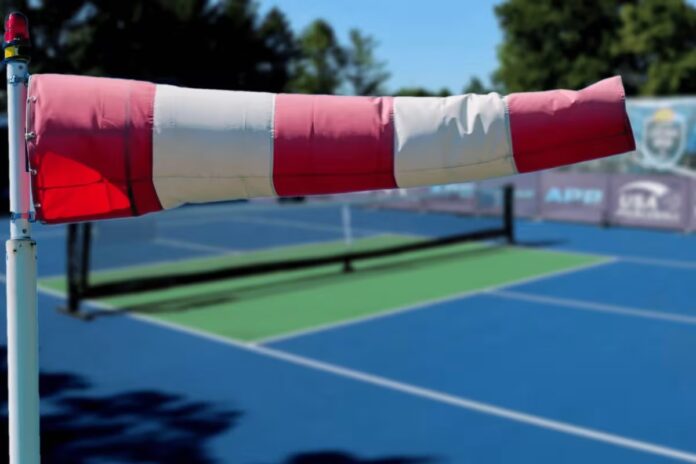Mastering Pickleball in Windy Conditions: Handling the challenges of pickleball on a calm day is already demanding due to its fast-paced movement and quick reflexes. However, when wind becomes a factor, the game can shift from challenging to chaotic. Learning how to play pickleball in windy conditions is an essential skill that can significantly impact the success of beginners and experienced players.
The Impact of Wind on Pickleball
Wind can fundamentally change the dynamics of pickleball, influencing ball behavior, player movement, and overall pickleball strategy. Here’s how wind affects various aspects of the game:
Unpredictable Ball Behavior
Wind causes pickleballs to move unpredictably, complicating the task of judging their landing spots. A gentle breeze can subtly deflect the ball, while stronger gusts may lead to erratic movement, reducing spin and bounce.
Shot Dynamics
When the wind is at players’ backs, shots tend to fly farther, while hitting into the wind requires more energy and precision to maintain play. Players must adjust their shot strength accordingly.
Player Mobility
Wind affects how players move around the court, making balance and quick repositioning crucial. Adapting posture to stay grounded in gusty conditions is essential for maintaining control.
Key Pickleball Techniques for Playing in the Wind
- Emphasize Controlled Shots: In windy conditions, long, powerful strokes can be risky. Players should focus on shorter, more controlled shots rather than relying solely on strong drives and slams. Dinking—gently hitting the ball just over the net—becomes particularly useful in these scenarios.
- Adapt to Wind Direction: Understanding how wind direction impacts gameplay is vital. Here are strategies for different wind situations:
- With the Wind: Shots will travel farther, so players should aim for gentle strokes with precise placement.
- Against the Wind: Extra power is necessary to reach normal distances, and players should aim lower to prevent the ball from floating high and becoming an easy target for opponents.
- Crosswinds: Wind blowing sideways can complicate shots, so players need to adjust their aim to counteract the wind’s effects.
- Maintain Patience and Control: Windy conditions can be frustrating, leading to misjudged shots and erratic ball movement. Instead of trying to compensate by hitting harder, players should focus on consistency and control, remaining calm amid the challenges.
- Enhance Positioning Skills: Footwork becomes even more critical in windy conditions. Players may need to adjust their positioning quickly to respond to sudden gusts affecting the ball’s trajectory.
- Anticipate Movement: Players should expect how the wind will impact the ball and position themselves accordingly.
- Stay Balanced: Maintaining balance and adjusting stance for wind shifts is crucial to avoid overcommitting.
- Refine Serving Techniques: Serving in the wind poses unique challenges. Players can make the following adjustments:
- Into the Wind: Aggressive serves work well since the wind slows the ball. Flat serves with added spin can help maintain control.
- With the Wind at Their Backs: Caution is needed, as high serves may float out. Players should opt for lower, controlled serves to ensure accuracy.
- Lower Toss: A lower toss enhances control, particularly in strong winds.
- Utilize Spin Effectively: Adding spin to shots can help mitigate the wind’s influence. Topspin can keep shots lower and increase their chances of landing in play, while backspin can slow the ball and keep it low.
- Cultivate Mental Resilience: The unpredictable nature of wind can transform the game into a psychological challenge. When usual shots fall short or miss due to the wind, frustration can build.
- Stay Positive: Recognizing that both players are facing the same conditions can help maintain a positive mindset. Viewing wind as an opportunity to showcase mental resilience is crucial.
- Adjust Expectations: Windy games often result in more mistakes, so players should accept that their usual tactics may require adjustment.
- Communicate Effectively with Partners: In doubles, communication becomes even more vital in windy conditions. Clear discussions about shot responsibilities are essential, as wind can alter the ball’s path unexpectedly.
- Talk More: Maintaining open lines of communication during play is crucial for adapting to wind influences.
- Cover More Ground: Adjusting stances and anticipating extra movement due to the wind helps players navigate the court better.

Advanced Pickleball Strategies for Windy Play
Once players have grasped the basics, they can implement advanced pickleball techniques to enhance their performance on windy days:
- Practice Against the Wind: If windy conditions are expected, warming up against the wind can help players understand the ball’s behavior and required shot force.
- Modify Net Play: Wind impacts shots near the net as much as groundstrokes. Players should avoid overly aggressive net play during strong winds, opting to let the ball bounce more often for better control.
- Leverage Wind for Strategic Advantage: Players can use the wind to create challenging shots. A well-placed lob may force opponents to recover effectively when the wind is behind them, while cross-court shots can create awkward angles.
- Vary Shot Heights: Changing shot heights disrupts opponents’ timing, particularly with wind influences. Combining low slices with high lobs challenges control and adaptability.
Choosing the Right Pickleball Gear for Windy Conditions
Selecting appropriate pickleball gear can enhance performance in windy situations. Here are some recommendations:
- Pickleball Paddle: A heavier paddle provides more stability in windy conditions. If players typically use a lightweight paddle, switching to a heavier option can improve control.
- Pickleball Selection: Different types of pickleballs behave uniquely in the wind. Outdoor balls are designed to withstand wind better than indoor balls, and players should consider balls with smaller holes to minimize wind impact.
- Appropriate Pickleball Clothing: Dressing suitably for windy conditions is vital. Players should wear breathable layers to accommodate temperature fluctuations while avoiding loose-fitting clothes that may hinder movement.

News in Brief: Mastering Pickleball in Windy Conditions
Playing pickleball in windy conditions poses unique challenges, affecting ball behavior and shot dynamics. Key pickleball strategies include using controlled shots, adjusting to wind direction, maintaining patience, enhancing footwork, refining serving techniques, utilizing spin, cultivating mental resilience, and effective communication.
Choosing the right pickleball gear, such as heavier paddles and outdoor balls, can further improve performance on windy days.
ALSO READ: Master Shot Placement in Pickleball to Unlock the Full Potential on the Pickleball Court


